
Europe and Mediterranean: Classic Christmas Markets Cruise
Uniworld Boutique River Cruises
Sail through Christmas country, trying Frankfurt's famous apple cider and Nuremberg's gingerbread. Throughout, cozy up to steaming mugs of glühwein (warm spiced wine) and do as the locals do by collecting different mugs from each stall and town you visit. Embrace the holiday spirit in Germany, the land where many Christmas traditions began, and find the magic of the season in the smiles that you meet along the way.

True All-Inclusive Boutique River Cruising™
All gratuities for onboard services
Unlimited fine wine, beer, spirits and nonalcoholic beverages**
Shore excursions with local experts as your guide
Internet and Wi-Fi
All arrival and departure day transfers
Executive Member Benefit
Executive Members receive an annual 2% Reward, up to $1,250, on qualified Costco Travel purchases
Receive a US $ 50 shipboard credit per person (maximum US $ 100 per stateroom)♦
Digital Costco Shop Card
Member Exclusive: Digital Costco Shop Card with every Uniworld river cruise†
Sailing Itinerary

Note: Cruise itineraries are subject to change. Please verify ports and times directly with the cruise line.
Overview
Nuremberg is the largest city in Franconia and the natural centre of North Bavaria. In terms of population it is the second largest city in Bavaria and the thirteenth largest in Germany. Together with its neighbours Fürth, Erlangen, Schwabach and the surrounding rural districts, Nuremberg is part of one of Europe’s most important economic areas, where the EU and its Eastern neighbours meet. Nuremberg is surrounded by attractive landscapes: to the East the Franconian hills, to the North "Franconian Switzerland" and to the South-West the Franconian Lakes. Centuries of art and architecture made Nuremberg a treasure. During the 15th and 16th centuries, Nuremberg enjoyed a cultural flowering that made it the center of the German Renaissance, bringing together Italian Renaissance and German Gothic traditions. In the artists' workshops were found such great talents as Veit Stoss, Peter Vischer, Adam Krafft, Michael Wolgemut, and above all, Albrecht Dürer. Koberger set up his printing press here, and Regiomontanus built an astronomical observatory. Here, too, flourished the guilds of the Meistersingers, composed of prosperous artisans; Wagner made their most famous member, Hans Sachs, the hero of his opera Die Meistersinger von Nuremberg. Many of Nuremberg's most important buildings, including some of the finest churches in Germany, have been restored or reconstructed. The old part of the city, the Altstadt, lies mainly within a pedestrian zone. Today's visitors can see the ruins of the ramparts that once surrounded the city as well as more modern sites, such as the Justice Palace, where the War Crimes Tribunal sat in 1946. Visitors can also see the Zeppelinfeld arena, the huge amphitheater where, from 1927 to 1935, Hitler staged those dramatic Nazi rallies that were immortalized by Leni Riefenstahl in Triumph des Willens (Triumph of the Will). Hitler's architect, Albert Speer, constructed what has been called a "concrete mecca," whose grounds today have been turned into a park with apartment blocks, a trade fair, and a concert hall. Speer's Congress Hall, larger than the Colosseum in Rome, has become a recording studio and warehouse.
Overview
Nuremberg is the largest city in Franconia and the natural centre of North Bavaria. In terms of population it is the second largest city in Bavaria and the thirteenth largest in Germany. Together with its neighbours Fürth, Erlangen, Schwabach and the surrounding rural districts, Nuremberg is part of one of Europe’s most important economic areas, where the EU and its Eastern neighbours meet. Nuremberg is surrounded by attractive landscapes: to the East the Franconian hills, to the North "Franconian Switzerland" and to the South-West the Franconian Lakes. Centuries of art and architecture made Nuremberg a treasure. During the 15th and 16th centuries, Nuremberg enjoyed a cultural flowering that made it the center of the German Renaissance, bringing together Italian Renaissance and German Gothic traditions. In the artists' workshops were found such great talents as Veit Stoss, Peter Vischer, Adam Krafft, Michael Wolgemut, and above all, Albrecht Dürer. Koberger set up his printing press here, and Regiomontanus built an astronomical observatory. Here, too, flourished the guilds of the Meistersingers, composed of prosperous artisans; Wagner made their most famous member, Hans Sachs, the hero of his opera Die Meistersinger von Nuremberg. Many of Nuremberg's most important buildings, including some of the finest churches in Germany, have been restored or reconstructed. The old part of the city, the Altstadt, lies mainly within a pedestrian zone. Today's visitors can see the ruins of the ramparts that once surrounded the city as well as more modern sites, such as the Justice Palace, where the War Crimes Tribunal sat in 1946. Visitors can also see the Zeppelinfeld arena, the huge amphitheater where, from 1927 to 1935, Hitler staged those dramatic Nazi rallies that were immortalized by Leni Riefenstahl in Triumph des Willens (Triumph of the Will). Hitler's architect, Albert Speer, constructed what has been called a "concrete mecca," whose grounds today have been turned into a park with apartment blocks, a trade fair, and a concert hall. Speer's Congress Hall, larger than the Colosseum in Rome, has become a recording studio and warehouse.
Overview
Situated in the heart of Upper Franconia, Bamberg is a historical yet dynamic city. It is a town of tradition and progress, both of which successfully complement each other. In short, Bamberg is a beautiful city which for many reasons is always worth a visit. The locals like to stress that their city spreads across seven hills like Rome has a network of waterways like Venice, and an old city that is at least as beautiful as Prague and on which the same architects left their unmistakable mark. Those who know Bamberg will agree that these claims are not unjust. A glance at just four of the many sights is enough to understand why. The Old Town Hall, which like the bow of a ship parts the flow of the River Regnitz, can only be reached by two stone bridges; the Romanesque/Gothic Cathedral is endowed with four unique towers of the same height; the picturesque fishermen's houses of "Little Venice" prop each other up on the river bank and the magnificent New Residence boasts a splendid baroque room known as the Emperor's Hall. Bamberg is not just a work of art that happens to be of historical interest but a dynamic, pulsating city with a population of 70,000. Bamberg has all the facilities a city, its inhabitants, and visitors need. It is ideal for shopping, working and living, for spending holidays and holding conferences. After just a few hours in Bamberg, every visitor comes away with that special Bamberg feeling. Bamberg offers a wide and interesting range of leisure facilities; it knows how to please the eye, appeal to the ear, and surprise the tastebuds. In summer, Bamberg's beer cellars or "Keller" are a special attraction. Here the locals and tourists can appreciate a locally brewed beer and savour a typical Franconian snack. Bamberg is a lovely town for those who also enjoy a stroll. The possibilities are many and include the Hain, an extensive wooded park on the periphery, or the pretty paths along the canals and the River Regnitz. Bamberg has a lot to offer not only for those who have cultural leanings but also for those who enjoy sports.
Overview
Wurzburg is a city in Germany's Bavaria region. It's known for lavish baroque and rococo architecture, particularly the 18th-century Residenz palace, with ornate rooms, a huge fresco by Venetian artist Tiepolo and an elaborate staircase. Home to numerous wine bars, cellars and wineries, Wurzburg is the center of the Franconian wine country, with its distinctive bocksbeutel (bottles with flattened round shapes).
Overview
Wurzburg is a city in Germany's Bavaria region. It's known for lavish baroque and rococo architecture, particularly the 18th-century Residenz palace, with ornate rooms, a huge fresco by Venetian artist Tiepolo and an elaborate staircase. Home to numerous wine bars, cellars and wineries, Wurzburg is the center of the Franconian wine country, with its distinctive bocksbeutel (bottles with flattened round shapes).
Overview
Wertheim Village, Germany's first premium outlet shopping destination, is nestled within the picturesque wine-growing region of the Tauber Valley, and near Wertheim, one of the country's most beautiful and romantic towns. The City of Wertheim, with its romantic historic town centre, a prominent Relais & Chateaux Resort, numerous traditional restaurants, and a wide range of recreational and cultural amenities, is a well-established tourist destination popular with the residents of Frankfurt and its many affluent suburbs. Crowned by the spectacular ruins of Wertheim Castle, the city and its surroundings have long served as a preferred destination for scenic, cultural and gastronomic enjoyment. A dedicated shuttle service connects the historic city centre to Wertheim Village. Wertheim Village is strategically located at Junction 66 - Wertheim/Lengfurt - of the A3 Autobahn, within 60 minutes from each of Frankfurt and Nuremberg. The Village is in the State of Baden-Württemberg and on the border of Bavaria. It enjoys over 500 metres of motorway frontage and sits prominently on an idyllic hillside offering a spectacular view to the more than 23.5 million vehicles passing the site each year. Moreover, Wertheim's location just west of the Autobahn A3/A7 interchange makes it readily accessible to the more than 50 million people annually passing through the region. The design of Wertheim Village is a creative interpretation of the regional Franconian architectural style, using exquisite details and high-quality materials to express the historic traditions of building craft for which the region is world famous. Varied façades, an animated roofscape, decorative art detailing and rich landscaping provide customers with a unique, engaging and romantic shopping environment. The Village has spacious and high-quality restrooms, baby changing facilities, a Tourist Information Centre aimed at promoting the Village and the region as a major tourist destination, public phones, restaurants and cafés, and amenities to provide a satisfying customer visit. Wertheim Village is located near the intersection of the famed Castle Route and the Romantic Road - two of the most important and popular tourist itineraries in Europe. Reaching from Mannheim to Prague, and from nearby Würzburg to the Alps, this dynamic tourist region includes such nearby destinations as Rothenburg ob der Tauber, with some 2.5 million annual visitors, the UNESCO World Heritage Residenz Castle in Würzburg, mediaeval Nuremberg with its world-famous Christmas Market, plus countless castles, forts, wineries and spas. Other important sources of tourism are the frequent trade fairs and congresses in Frankfurt, which attract an additional 12 million international visitors to the region each year.
Overview
Frankfurt am Main is the largest city in the German state of Hesse and the fifth largest city in Germany. Situated on the Main River, it has a population of approximately 650,000 (but about 5 million in its metropolitan area). Among English speakers, it is usually known as simply Frankfurt, but Germans call it by its full name too distinguishing it from another Frankfurt in Germany, Frankfurt an der Oder. It was once called Frankfort-on-Main in English, a direct translation of Frankfurt am Main. The three pillars of Frankfurt's economy are finance, trade fairs, and transport; it is the transport hub of Germany. Frankfurt has been Germany's financial capital for centuries. Frankfurt is often called "Bankfurt" or "Manhattan" (derived from the local Main River). It is one of only three European cities that have a significant number of high-rise skyscrapers. With 9 skyscrapers taller than 150 meters (492 feet) in 2004, Frankfurt is second behind Paris (La Défense and Montparnasse: 12 skyscrapers taller than 150 meters, not counting the Eiffel Tower), but ahead of London (Canary Wharf and City: 8 skyscrapers taller than 150 meters). The city of Frankfurt contains the tallest skyscraper in Europe, the Commerzbank Tower. In Germany, only Frankfurt and Düsseldorf have high-rise skyscrapers. Frankfurt is renowned for its finance industry, on par with London and Paris, as well as for its central location in Western Europe, surrounded by the most populous areas of Europe. It has a first-class infrastructure and a major international airport: Frankfurt International Airport. It is the second or third busiest in Europe, depending on the data used. Passenger traffic in 2003 was 48,351,664, second in Europe behind London Heathrow Airport (63,487,136), almost in a tie with Paris Charles de Gaulle Airport (48,220,436). Frankfurt has a huge number of institutions, among them its university, Johann Wolfgang Goethe-Universität, as well as several museums, most of them lined up along the Main river on the Museumsufer (museum shore) and a large botanical garden, the Palmengarten. The best-known museums are the Städelsches Kunstinstitut und Städtische Galerie, called Städel, and the Naturmuseum Senckenberg. The Museum für moderne Kunst (Museum of Modern Art) and Schirn Kunsthalle (Schirn Art Galery) are also notable.
Overview
Frankfurt am Main is the largest city in the German state of Hesse and the fifth largest city in Germany. Situated on the Main River, it has a population of approximately 650,000 (but about 5 million in its metropolitan area). Among English speakers, it is usually known as simply Frankfurt, but Germans call it by its full name too distinguishing it from another Frankfurt in Germany, Frankfurt an der Oder. It was once called Frankfort-on-Main in English, a direct translation of Frankfurt am Main. The three pillars of Frankfurt's economy are finance, trade fairs, and transport; it is the transport hub of Germany. Frankfurt has been Germany's financial capital for centuries. Frankfurt is often called "Bankfurt" or "Manhattan" (derived from the local Main River). It is one of only three European cities that have a significant number of high-rise skyscrapers. With 9 skyscrapers taller than 150 meters (492 feet) in 2004, Frankfurt is second behind Paris (La Défense and Montparnasse: 12 skyscrapers taller than 150 meters, not counting the Eiffel Tower), but ahead of London (Canary Wharf and City: 8 skyscrapers taller than 150 meters). The city of Frankfurt contains the tallest skyscraper in Europe, the Commerzbank Tower. In Germany, only Frankfurt and Düsseldorf have high-rise skyscrapers. Frankfurt is renowned for its finance industry, on par with London and Paris, as well as for its central location in Western Europe, surrounded by the most populous areas of Europe. It has a first-class infrastructure and a major international airport: Frankfurt International Airport. It is the second or third busiest in Europe, depending on the data used. Passenger traffic in 2003 was 48,351,664, second in Europe behind London Heathrow Airport (63,487,136), almost in a tie with Paris Charles de Gaulle Airport (48,220,436). Frankfurt has a huge number of institutions, among them its university, Johann Wolfgang Goethe-Universität, as well as several museums, most of them lined up along the Main river on the Museumsufer (museum shore) and a large botanical garden, the Palmengarten. The best-known museums are the Städelsches Kunstinstitut und Städtische Galerie, called Städel, and the Naturmuseum Senckenberg. The Museum für moderne Kunst (Museum of Modern Art) and Schirn Kunsthalle (Schirn Art Galery) are also notable.
Onboard the S.S. Emilie
S.S. Emilie
Year Built: 2026
Double Occupancy Capacity: 154
Sailing the Danube River, the next member of Uniworld’s Super Ship™ fleet will be inspired by master Viennese painter Gustav Klimt. In his honor, the vessel is named after his beloved muse, Emilie Flöge. When she debuts in 2026, the S.S. Emilie will bring elements of Klimt’s signature style to guests, with dramatic hues, Art Nouveau elements, and stunning pops of gold. Guests who book a Grand Suite and the adjoining Deluxe French Balcony next door can see their stateroom transformed into an incredibly spacious 2-bedroom suite.
Activities & Services (included in cruise)
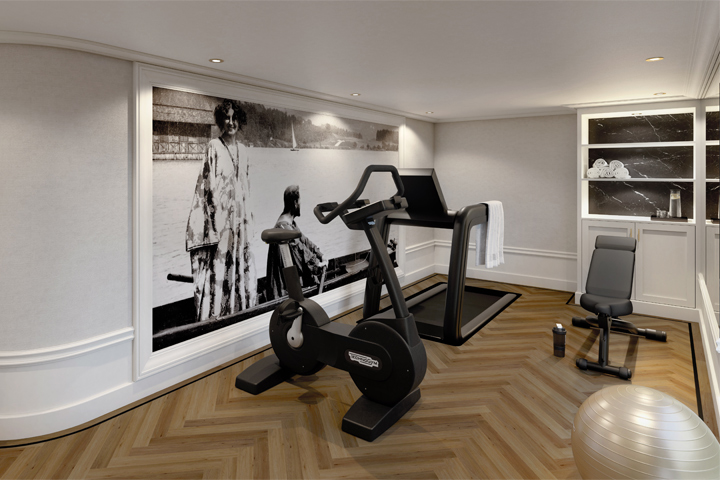
Fitness Lounge
- Movies
- Fitness Center
- Fitness Classes
- Culinary Arts Center
- Educational Programs
- Guest Lecturers
- Complimentary Bicycles
- Bars/Lounges
- Onboard Entertainment
- Complimentary Wi-Fi
- Organized Age Specific Activities
- Concierge Desk
- Elevators
- Safe Deposit Boxes
- Self-Service Laundromat
Activities & Services (available for an extra fee)
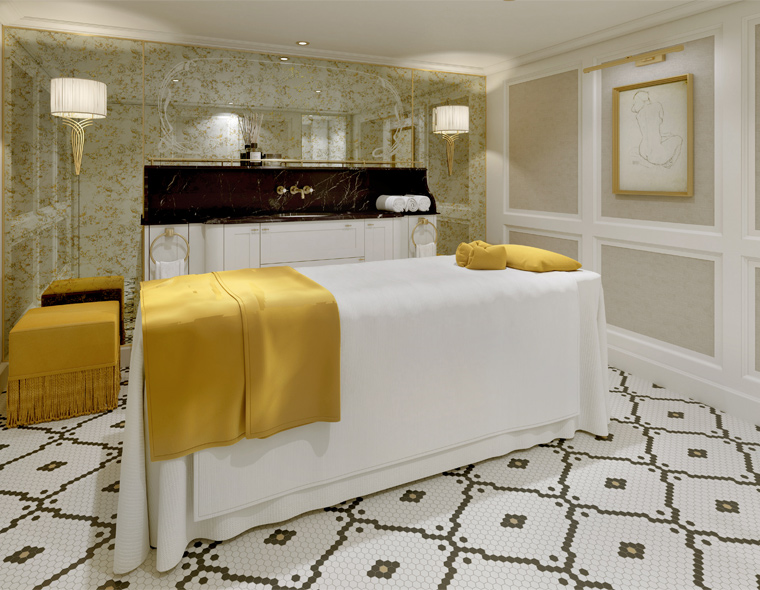
Spa
- Full-Service Spa
- Spa Services/Massage
- Dry Cleaning/ Laundry Service
- Duty-Free Shops/Boutiques
- Wedding/Vow Renewal
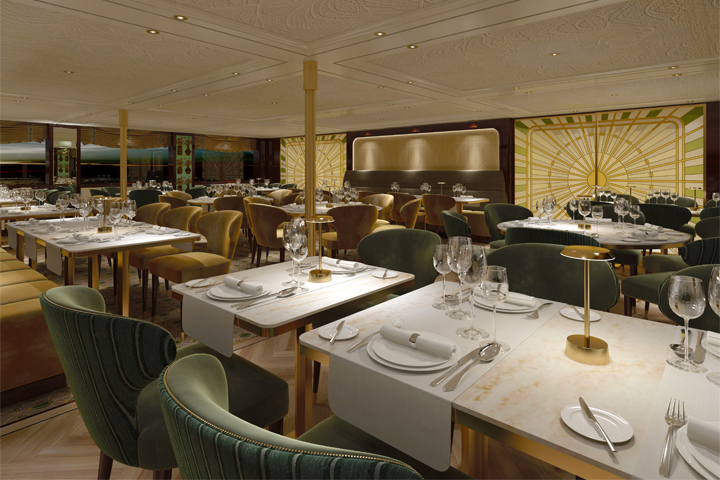
Gustav's Restaurant
Main Dining
Gustav's Restaurant: A great meal is a feast for all the senses and that starts from the moment you step into the dining room. Recline in utmost comfort on smooth velvet seating, bask in the warm glow of a room filled with golden hues and savor delicious dishes farm-to-table cuisine prepared by award-winning chefs.
All staterooms have Open-Air Balconies that, with the touch of a button, will lower the glass halfway to create a balcony-like effect. Adjoining staterooms are available; please inquire at the time of booking. While this is a beautiful and luxurious ship, its amenities may differ slightly from those of a Uniworld-company-owned ship.
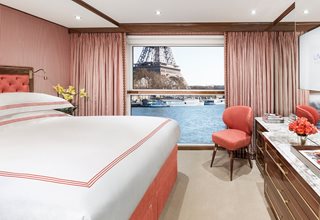
Category: FB
In-suite butler service, packing and unpacking assistance, in-room breakfast, daily fruit and cookie plate and an elegant evening snack, espresso machine and fine teas, fully stocked mini bar, bottle of wine upon request, shoeshine, and free laundry service.
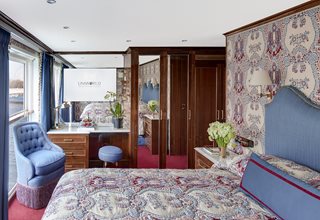
Category: S

| Symbol | Description |
|---|
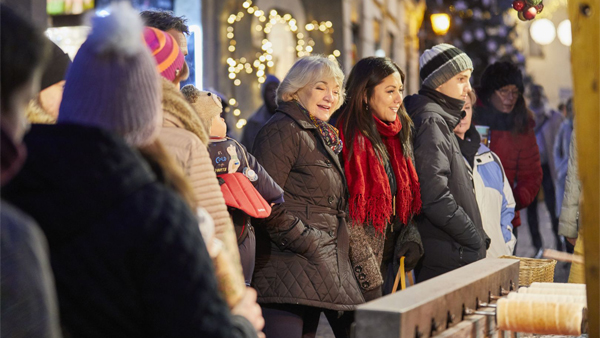
- Ship Name: S.S. Emilie
- Year Built: 2026
- Year Entered Present Fleet: 2026
- Ship Class: River Super Ship
- Maximum Capacity: 154
- Number of Passenger Decks: 3
- Number of Crew: 57
- Officers' Nationality: European/International
- Ocean-View without Balcony: 55
- Ocean-View with Balcony: 10
- Capacity Based on Double Occupancy: 154
- Country of Registry: Switzerland
- Total Staterooms: 77
- Suites with Balcony: 12
- Crew/Hotel Staff Nationality: European/International
Available Dates & Prices
Terms & Conditions
*Price shown is per person based on double occupancy, is valid for select stateroom categories only, and does not include government taxes/fees and gratuities. Click on the Terms & Conditions link below for details.
**Unlimited beverages include premium wine and premium spirits. Diamond List of wine and spirits is available at an additional cost.
♦Executive Members receive a US $ 50 shipboard credit per person, maximum US $ 100 per stateroom. Executive Member benefit is valid for primary cardholder only. Shipboard credit is per stateroom based on double occupancy. Shipboard credit will be applied to your onboard account. Any unused portion of the credit is nontransferable, nonrefundable and may not be redeemed for cash.
†One Digital Costco Shop Card per room/stateroom, per stay. The exact amount of the Digital Costco Shop Card will be calculated during the booking process. The Digital Costco Shop Card promotion is nontransferable and may not be combined with any other promotion. A Digital Costco Shop Card will arrive by email approximately 10 days after the start of your cruise. Click on the Terms & Conditions link below for additional information.
Country of Registry: Switzerland
Digital Costco Shop Card
Book this vacation or cruise with Costco Travel and receive a Digital Costco Shop Card. The Digital Costco Shop Card is a convenient payment option in our warehouses and on Costco.ca.














